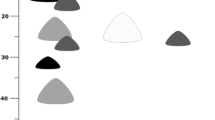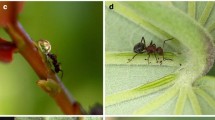Abstract.
We provide evidence for the proximate role of food in sex allocation by an ant species, and demonstrate how identity of the homopteran partner affects benefits to colonies of a plant-symbiotic ant. The system studied includes a plant-ant that nests in swollen hollowed internodes of a myrmecophyte, and two species of homopteran trophobionts (a coccid and a pseudococcid) tended inside domatia by these ants, for which they are an essential source of food. Total investment in pupae was greater for ant colonies that tended solely or primarily coccids than for those that tended pseudococcids. In particular, biomass invested in sexuals increased more rapidly with size of the colony in trees where ants tended coccids. This greater investment in sexuals was not made at the expense of investment in workers, but reflected increased resources available to coccid-tending colonies. Higher reproductive output indicates that ant fitness may be greater when they tend coccids. These additional resources led to a greater increase in production of alate females than in that of males. Consequently, the sex investment ratio of coccid-tending colonies was more female biased than in those that tended pseudococcids. Differences in resource supply affected numbers of individuals produced but not per-individual investment, with one partial exception: in very small colonies, pseudococcid-tending colonies produced small workers while coccid-tending colonies did not, further underlining the higher resource supply to coccid-tending colonies. This study provides evidence for the proximate role played by food in sex allocation at the colony level. We discuss our results in the context of hypotheses aimed at explaining sex ratio at the colony and population levels.
Similar content being viewed by others
Author information
Authors and Affiliations
Additional information
Electronic Publication
Rights and permissions
About this article
Cite this article
Gaume, L., McKey, D. How identity of the homopteran trophobiont affects sex allocation in a symbiotic plant-ant: the proximate role of food. Behav Ecol Sociobiol 51, 197–205 (2002). https://doi.org/10.1007/s002650100416
Received:
Accepted:
Issue Date:
DOI: https://doi.org/10.1007/s002650100416




